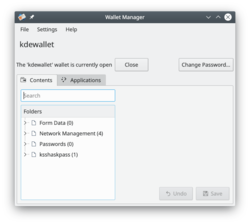KDE Wallet Manager/zh-cn: Difference between revisions
(Updating to match new version of source page) |
(Updating to match new version of source page) |
||
| Line 2: | Line 2: | ||
{|class="tablecenter vertical-centered" | {|class="tablecenter vertical-centered" | ||
|[[Image:Kwalletmgr.png|250px]]|| ||''' | |[[Image:Kwalletmgr.png|250px]]|| ||'''KWalletManager manages some of your passwords in an encrypted file - but Kgpg does not use Kwallet, neither does firefox.''' | ||
|} | |} | ||
| Line 20: | Line 20: | ||
点击(或在某些版本里是双击)一个钱包允许你检查钱包的内容。这里,你可以移除那些你不希望被钱包控制的项目。还有一个好处是用来检查单个项目的密码 - 如果你错误的输入了密码并储存了它的话尤其有用。因为你只有给定密码才能这样操作,所以这些操作依旧是安全的。 | 点击(或在某些版本里是双击)一个钱包允许你检查钱包的内容。这里,你可以移除那些你不希望被钱包控制的项目。还有一个好处是用来检查单个项目的密码 - 如果你错误的输入了密码并储存了它的话尤其有用。因为你只有给定密码才能这样操作,所以这些操作依旧是安全的。 | ||
{{ | {{Tip|1=''For greater security'' configure '''KWalletManager''' to use one wallet for local passwords and a separate one for network passwords and form data. | ||
---- | |||
Some apps, e.g. ''octopi'', offer multiple options for password entry, e.g. ''gksu'' besides kdesu. gksu then offers to store a password, say the root password, in the gnome-keyring to save you the bother of repeated entering of the password in short intervals of time. That gnome keyring is a "wallet" separate from the KDE-wallet. Another separate "wallet" is the file /etc/passwd for login passwords into Gnu/Linux. | |||
}} | |||
==提示和技巧== | ==提示和技巧== | ||
| Line 28: | Line 31: | ||
打开 '''KDE 钱包''',进入 <menuchoice>设置 -> 配置钱包... -> 访问控制</menuchoice>,调节程序设定。要是你之前误操作禁止程序使用'''KDE 钱包'''的话,这里就是后悔药。 | 打开 '''KDE 钱包''',进入 <menuchoice>设置 -> 配置钱包... -> 访问控制</menuchoice>,调节程序设定。要是你之前误操作禁止程序使用'''KDE 钱包'''的话,这里就是后悔药。 | ||
Use KDE-wallet with Python in a CLI: [http://www.mirbsd.org/kwalletcli.htm#b_pyex | Use KDE-wallet with Python in a CLI: [http://www.mirbsd.org/kwalletcli.htm#b_pyex CLI]. | ||
[[Category:工具/zh-cn]] | [[Category:工具/zh-cn]] | ||
[[Category:安全/zh-cn]] | [[Category:安全/zh-cn]] | ||
Latest revision as of 15:30, 6 August 2018
 |
KWalletManager manages some of your passwords in an encrypted file - but Kgpg does not use Kwallet, neither does firefox. |
KDE 钱包管理器 是个可选的工具,在维护安全时能够极大的有助于你的工作流程。
- 可以加密钱包
- 钱包默认关闭。需要你的密码来打开钱包
- 钱包可以设定成闲置时关闭
- 你可以控制哪个程序使用钱包 - 除此之外的程序必须要求密码。
右击 kwalletmanager 里的钱包,关联菜单提供如下维护选项:
- 创建新钱包
- 打开,检查选定的钱包
- 修改钱包的密码
- 中断某个当前使用钱包的程序的连接
- 关闭或删除钱包
点击(或在某些版本里是双击)一个钱包允许你检查钱包的内容。这里,你可以移除那些你不希望被钱包控制的项目。还有一个好处是用来检查单个项目的密码 - 如果你错误的输入了密码并储存了它的话尤其有用。因为你只有给定密码才能这样操作,所以这些操作依旧是安全的。
提示和技巧
如何让应用程序使用 KDE 钱包
打开 KDE 钱包,进入 ,调节程序设定。要是你之前误操作禁止程序使用KDE 钱包的话,这里就是后悔药。
Use KDE-wallet with Python in a CLI: CLI.

